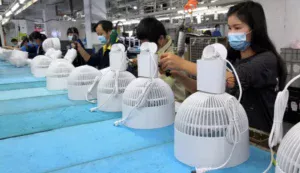Introduction
We have over 15 years of experience in the electric fan industry. The fan business is very seasonal.
From the supply chain perspective, material suppliers usually start their busy production season in October each year and continue until May of the next year.
From the market perspective, customers in the northern hemisphere mainly place orders from October to May, while customers in the southern hemisphere order from March to October.
Chinese Lunar New Year happens from January to February each year, with almost a one-month long holiday.
March is the global peak season for ordering and shipping.
If we cannot ship before then, delivery times can become unreliable.
Because of this, we usually prepare and stock up on materials for different orders in advance to handle these situations.
Strategies for Implementing Buffer Inventory
The fan industry requires both money and factory space.
To handle peak seasons in different regions, we usually start stocking materials from September to November each year.
If we send materials to the factory too early, the factory space gets filled up quickly, making it hard to move goods.
This causes the production lines to reduce or limit their output.
Additionally, paying for materials too early puts pressure on our finances.
If production is slowed down because there isn’t enough space, shipping becomes slower and it takes longer to get our money back.
In extreme cases, like when customers finish their products but don’t arrange shipping for a long time, there is a higher risk of bankruptcy.
Case Study Analysis
To maintain the flow of space and funds, we usually arrange production based on how easy it is to procure materials. Below is our company’s production plan:
1. Industrial Fans:
- Stators: These are the highest priority because we have many models and they are hard to arrange. Each time we receive materials, we have to wait 15-25 days, so we must stock them up in advance.
- Grilles: We need to stock some special sizes of grilles to handle shipments.
- Fan Blades: We need to stock some special sizes of fan blades to prevent long delivery times. For common sizes, we can arrange prepayments to make blanks in advance. When an order is confirmed, we can use the blanks for painting and finishing, saving time on ordering materials.
2. Orbit Fans/Auto Fans:
We must arrange to stock 10,000-20,000 grilles in advance.
We can stock regular poles and grilles. For special colors and special sizes, we must stock the materials.
4. Household Wall Fans and Table Fans:
We must stock materials for special colors and special sizes.
Cost and Benefit Analysis of the Strategy
If the materials are ready, we can arrange them to enter the factory in batches based on our production needs. It is important to do this in batches and not bring everything in at once.
Otherwise, the production and warehouse teams will be under a lot of pressure.
If the factory space is limited but we still need to bring in materials first, we have two other ways to ease the pressure:
- Rent a Warehouse Near the Factory:
- Pros: This greatly reduces the production pressure on our factory.
- Cons: Every time we need materials, we have to arrange people and vehicles to bring the materials to the production area, which adds extra costs.
- Use a Processing Factory:
- Pros: This method avoids the extra costs of moving materials back and forth.
- Cons: The processing factory needs to work closely with our production and quality control teams.
By using these methods, we can better manage our materials and keep production running smoothly.
Conclusion
Before 2018, our production plans were completed immediately upon receiving orders, and customers appreciated our ability to stock goods for quick shipments.
In 2020, the COVID-19 pandemic caused sea freight costs to soar, leading our warehouse to store over 80 containers.
As a result, our production team shifted to scheduling materials and shipments based on delivery times.
However, as the economy improved, this approach often led to longer shipment times due to unstable material supplies.
Through continuous adjustments, we developed an inventory buffer strategy that involves stocking non-standard or long-production-cycle parts.
This ensures we can handle slow supplier deliveries during off-seasons, maintaining smooth and timely shipments despite market fluctuations.

